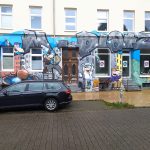Guten Tag an alle Leser,
ich möchte heute herzlich willkommen heißen zu meinem neuen monatlichen Bericht! Da ich mich gerade in den Semesterferien befinde, hatte ich die Gelegenheit, Rostock ausgiebig zu erkunden, insbesondere seine verschiedenen Stadtviertel. Jedes dieser Viertel hat seinen eigenen einzigartigen Stil und eine ganz besondere Atmosphäre, aber es gibt etwas, das sie alle miteinander verbindet: Graffiti in all seinen Facetten. Als Engländer fällt mir besonders auf, wie stark die Stadtflächen hier mit Graffiti verziert sind. Natürlich gibt es auch in großen englischen Städten Graffiti, aber ich habe den Eindruck, dass diese Kunstform in Deutschland und vor allem in Rostock überdurchschnittlich präsent ist.
In den letzten Wochen, in denen ich viel unterwegs war, habe ich versucht, die verschiedenen Arten von Graffiti in Rostock in drei allgemeine Kategorien einzuteilen. Aus meiner Sicht lassen sich diese als “Straßenkunst”, “sinnloses Graffiti” und “Hansa-Rostock-Graffiti”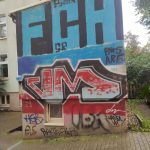 kategorisieren.
kategorisieren.
“Straßenkunst” ist für mich eine Form der Kunst, die echtes künstlerisches Talent und Können zeigt. Hierbei handelt es sich oft um großflächige Kunstwerke, die die Architektur des Gebäudes berücksichtigen und diese in das Kunstwerk integrieren, um einen zusätzlichen Effekt zu erzielen. Insbesondere das Viertel Kröpeliner-Tor-Vorstadt ist bekannt für verspielte Graffitiformen. Im Folgenden werde ich einige Bilder von Kunstwerken zeigen, die ich als Straßenkunst betrachte und die ich ästhetisch ansprechend finde. Ein gutes Beispiel dafür ist auch das Sonnenblumenhaus, über das ich vor einigen Monaten einen Bericht verfasst habe.
Die zweite Kategorie, die ich als “sinnloses Graffiti” bezeichne, umfasst die Art von Graffiti, die den meisten Menschen wohl als erstes in den Sinn kommt, wenn sie an Graffiti denken. Hierbei handelt es sich oft um groß geschriebene Worte in verschiedenen Schriftarten, die oft wenig bis keine Bedeutung haben. Dies empfinde ich persönlich als Vandalismus und verdienen keinen Platz in unserer Gesellschaft. Interessanterweise ist mir aufgefallen, dass die Bewohner von Rostock Maßnahmen ergriffen haben, um dem entgegenzuwirken, indem sie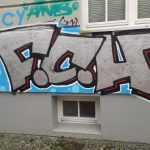 große Büsche oder Hecken vor ihren Hausfassaden pflanzen und hohe Zäune um ihre Häuser herum errichten.
große Büsche oder Hecken vor ihren Hausfassaden pflanzen und hohe Zäune um ihre Häuser herum errichten.
Die dritte Kategorie sind die “Hansa-Rostock-Graffiti”. Diese Art von Graffiti kann je nachdem der ersten oder zweiten Kategorie zugeordnet werden. Überall in der Stadt findet man die Buchstaben “FCH”. Diese Buchstaben stehen für den “Fußballclub Hansa (Rostock)”, den Namen der größten Fußballmannschaft hier in Rostock, die derzeit in der zweiten Liga des deutschen Fußballs spielt. Es gibt jedoch einige Graffiti im Namen von Hansa Rostock, die ich als künstlerisch ansprechend empfinde. Zweifelsfrei ist Graffiti auch ein Mittel der Wahl von Fußballfans geworden, ihre Unterstützung für ihre Fußballmannschaft auszudrücken.
Vielen Dank, dass Sie sich die Zeit genommen haben, meinen Bericht zu lesen. Bis zum nächsten Mal!
Jed
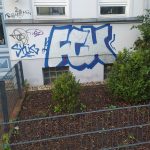 Hello to all readers,
Hello to all readers,
I would like to extend a warm welcome to my new monthly report today! As I am currently in the midst of my semester break, I have had the opportunity to explore Rostock extensively, particularly its various neighborhoods. Each of these neighborhoods possesses its own unique style and atmosphere, yet there is something that unites them all: graffiti, in all its forms. Being English, I cannot help but notice how prominently the cityscapes here are decorated with graffiti. While graffiti is certainly present in large English cities as well, I have the impression that this art form is exceptionally prevalent in Germany, especially in Rostock.
Over the past few weeks, during which I have been very much out and about, I have attempted to categorize the various types of graffiti in Rostock into three general groups. From my perspective, these can be classified as “street art,” “senseless graffiti,” and “Hansa Rostock graffiti.”
“Street art” represents, to me, a form of art that showcases genuine artistic talent and skill. These are often large-scale artworks that take into account the architecture of the building and incorporate it into the artwork to achieve an additional effect. Particularly, the Kröpeliner-Tor-Vorstadt district is renowned for its whimsical forms of street art. In the following, I will display some images of artworks that I consider to be street art and which I find aesthetically pleasing. A prime example of this is the Sunflower House, about which I wrote a report a few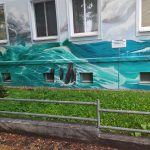 months ago.
months ago.
The second category, which I refer to as “senseless graffiti,” encompasses the type of graffiti that most people likely associate with the term “graffiti.” It often consists of prominently written words in various fonts, which frequently carry little to no discernible meaning. Personally, I view this as vandalism and believe it has no place in our society. Interestingly, I have noticed that the residents of Rostock have taken measures to counteract this by planting large bushes or hedges in front of their house facades and erecting tall fences around their homes.
The third category comprises “Hansa Rostock graffiti.” Depending on the context, this type of graffiti can be assigned to either the first or second category. Throughout the city, one can find the letters “FCH.” These letters stand for the “Football Club Hansa (Rostock),” the name of the largest football team here in Rostock, currently competing in the second division of German football. There are however some graffiti pieces created in the name of Hansa Rostock that I do find artistically appealing. Undoubtedly, graffiti has also become a chosen means for football fans to express their support for their football team.
Thank you a lot for taking the time to read my report. Until next time!
Warm regards,
Jed